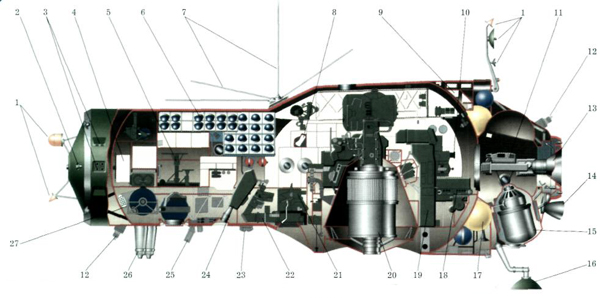Almaz
Almaz is a military program, which was implemented in the period 1965-1981. Preliminary design of Almaz space-rocket complex was developed by the OKB-52 design bureau (currently known as NPO Mashinostroyeniya) under the leadership of Chief Designer Vladimir Chelomey. The Almaz complex included Almaz orbital station and resupply spacecraft, which had to deliver crew of 3 cosmonauts, equipment, and descent modules to the station.
Almaz were known as OPS, from Orbital Piloted Station. Station was designed as military reconnaissance and observation station, which was equipped with sensors, photographic equipment, and accurate self-navigation system. The Almaz station 11F71 (Russian: 11Ô71) basic design features are 4.15 meters in diameter, a weight of 18.9 tones and total length of 11.61 meters. Station had one descent capsule 11F76 (Russian: 11Ô76), which was designed to deliver to the Earth up to 100 kg of cargo. Almaz was inserted into the Earth orbit by three-stage Proton rocket (UR-500K).
In total, there were three Almaz stations, inserted into the orbit (the Salyut-2, Salyut-3, Salyut-5) and three crews worked onboard two of these stations (one on the Salyut-3 and two on the Salyut-5). The Almaz OPS-1 was launched on April 3, 1973. After insertion it was named Salyut-2. The station was no more in use from May 28, 1973 because of modules depressurization. The Almaz OPS-2 was launched on June 25, 1974. Station was named Salyut-3. The Almaz OPS-3 was launched on June 22, 1976 and had a name Salyut-5. The crews were delivered to the station by the Soyuz 7K-T transport vehicles. In 1978, it was planned to launch the next Almaz station. The OPS-4, unlike previous stations, had two docking ports, but at the end of 1978 it was decided to stop works on Almaz manned space stations program. The OPS-4 was deactivated. Nowadays it is located in NPO Mashinostroyeniya.

After that, production of three Almaz-T automatic stations based on the Almaz OPS was started. The stations were equipped with advanced photo and television equipment and surveillance radar equipment. Almaz-T stations were designed with the possibility of cosmonauts visits in order to carry out maintenance and repair work for prolonging operational life of the station.
Resupply spacecraft (11F72) was designed in 1970s in a branch of OKB-52 (currently known as Salyut Bureau). It was designed as a manned transport vehicle for delivering crews of three members, fuel, supplies, equipment, and seven descent capsules 11F76 to the OPS Almaz.
Structurally, resupply spacecraft with weight of 20 tons consisted of the Functional Cargo Block (FGB) 11F77, and descent capsule 11F74. The cosmonauts performed flights in Sokol-KV space suits.
Resupply spacecrafts and descent capsules were inserted into the Earth orbit by three-stage Proton rocket. In December of 1981 it was decided to stop using resupply spacecraft as manned transport vehicle. After that two vehicles were launched as automated cargo vehicles. The program was closed after spacecraft fourth flight. In the mid-1980s the designing of modules for the Mir space station was started on the base of resupply spacecraft.


